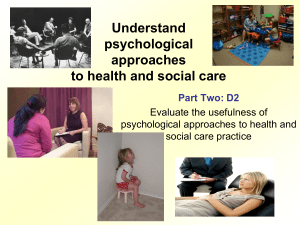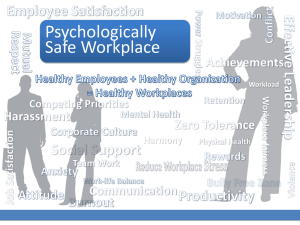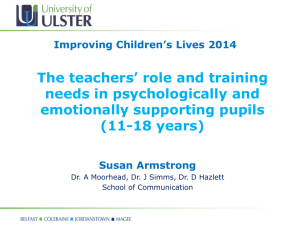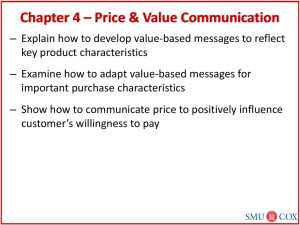to view presentation - Youth Homeless North East
advertisement
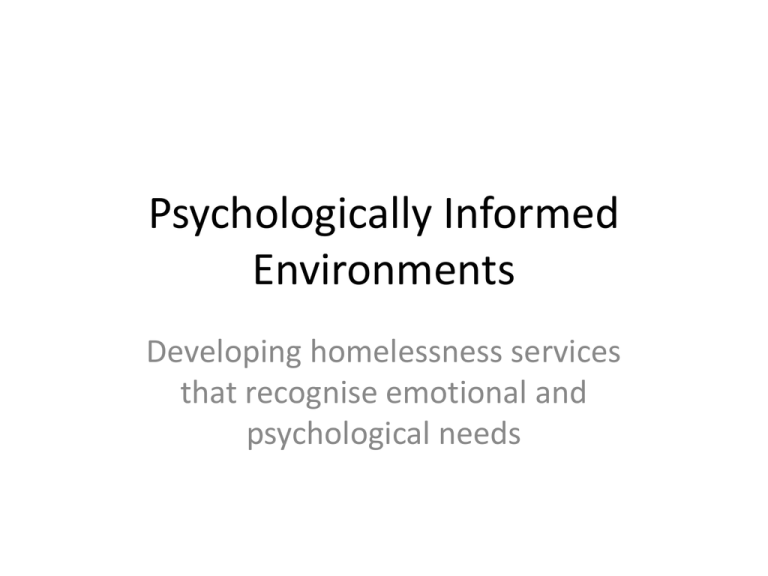
Psychologically Informed Environments Developing homelessness services that recognise emotional and psychological needs Psychologically Informed Environments • A presentation by Helen Keats, National Rough Sleeping Advisor, Dr Nick Maguire, Southampton University and Peter Cockersell, St Mungos • It will outline the key themes of the PIE guidance, explain what PIEs are and describe how St Mungos is changing its services into ones which are psychogically aware. Psychologically Informed Environments • Recent research suggests that behaviour which can increase the likelihood of homelessness may be associated with mental health problems such as: • • personality disorder • • post-traumatic stress disorder • • complex trauma; or • • conduct disorders in children. Psychologically Informed Environments • Research carried out by Dr Nick Maguire at Southampton University on behalf of the Department of Communities and Local Government (DCLG) 2009/10 identified that up to 60% of adults living in hostels in England have diagnosable personality disorder compared with about 4.4% in the general population. Psychologically Informed Environments • The research led to the publication of non statutory guidance: “Meeting the psychological and emotional needs of homeless people” July 2010 and development of the concept of Psychologically Informed Environments. • www.nmhdu.org.uk/complextrauma • The concept of a PIE was originally developed by Robin Johnson and Rex Haigh, as part of the Royal College of Psychiatrists’ Enabling Environments initiative. Psychologically Informed Environments • Psychologically Informed Environments (PIEs) recognise and tackle the ways in which people with complex trauma can behave, and which can often result in eviction, exclusion and rough sleeping. Psychologically Informed Environments People who have experienced homelessness and who experience complex trauma can prove difficult to engage with, demonstrate volatile, irresponsible, risky or antisocial behaviour and use drugs and alcohol as a form of self medication. They may behave and think in particular ways which perpetuate their problems. This makes key working very hard and at times frustrating for both client and worker Psychologically Informed Environments • There are particular issues to consider around 16-17 year-olds who may have had traumatic and abusive childhoods. On top of the problems of adolescence which affect young people generally, they may also exhibit behavioural problems such as conduct disorder, often associated with antisocial behaviour which can lead to homelessness Psychologically Informed Environments • Some people may for example: • • self-harm or have an uncontrolled drug and/or alcohol problem • • appear impulsive and not consider the consequences of their actions • • appear withdrawn or socially isolated and reluctant to engage with help which is offered • • exhibit anti-social or aggressive behaviour • • lack any structure or regular daily routine • • not have been in work or education for significant periods of time • • have come to the attention of the criminal justice system due to offending Psychologically Informed Environments The initial guidance on the PIE concept has been followed by an operational guide for commissioners and service providers which explains how to develop PIEs. It can be found at www.homelesshealthcare.org.uk Psychological Frameworks • Number of different psychological frameworks available: – Cognitive-behavioural, Dialectical behavioural – Psychodynamic – Person-Centred approaches • Main aim is to enable people to reflect on internal experiences (thoughts and feelings) • Enable choice about behaviours • Work through interpersonal relationships Functions of psychological thinking • Staff: – Enable reflection to make more considered decisions around client behaviour • Choice – Enable reflection on difficult emotions (anger, anxiety, hopelessness); reduce burnout, rumination about difficult situations; – Increase confidence establishing and maintaining interpersonal relationships Functions of psychological thinking • Service users – Enhance individuals’ abilities to make meaningful change – Increase in ‘functional’ behaviours; reduction in ‘asocial’ behaviours – Increase in quality of interpersonal relationships – Manage emotions Psychological frameworks • Emotion dyregulation a key issue – Relationship between early abuse and maladaptive behaviours • Enabling people to better regulate emotions beneficial in terms of consequent behaviour • Achieved in a number of different ways, e.g. – Skills teaching and rehearsal – Interpersonal relationships Enabling psychological thinking • Thinking psychologically is a skill • Training useful • Must be accompanied by rehearsal of that skill – One of the functions of regular supervision Summary • Staff can learn skills through training and reflective practice • To more effectively: – Help themselves – Help their clients engage in change • Psychological thinking can inform design of environments – http://www.healinglandscapes.org/resources/ebd.ht ml – http://www.healthdesign.org/ Five principles • Social space • Staff support • Psychological framework • Managing relationships • Evaluation Managing Relationships • Complex trauma arises from abusive relationships • Healing relationships need to be managed, and take care, and time • Relationships have an impact on both/all parties • Group dynamics affect individual group members’ relationships • Setting up PIEs is also about managing relationships Setting up a PIE • Social space • Training and support • Reflective practice • Psychological framework • Organisational buy-in St Mungo’s model • 4 training modules: – Managing relationships 1 – Managing relationships 2 – The Escape Plan – Enabling management • Recovery • Access to psychodynamic psychotherapy • Facilitated reflective practice Evaluation • Outcomes monitoring • Client and staff experience • Wider impact • Organisational learning Setting up PIEs • • • • It’s about creative, not directive, support Beware of technical language, it divides Clinical input is part of the team approach Power changes can produce powerful resistance, and/or big changes • Positive client outcomes are what we’re trying to achieve Contact details Helenkeats@gmail.com nm10@soton.ac.uk peter.cockersell@mungos.org Five principles • Social space • Staff support • Psychological framework • Managing relationships • Evaluation


